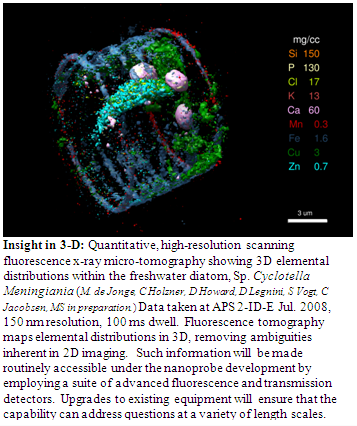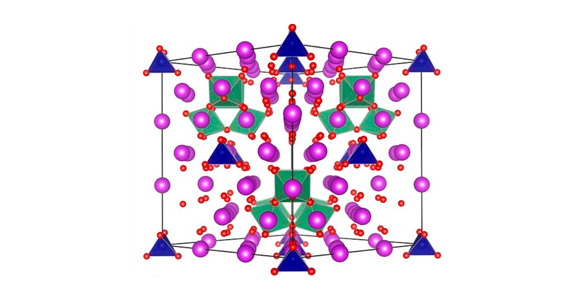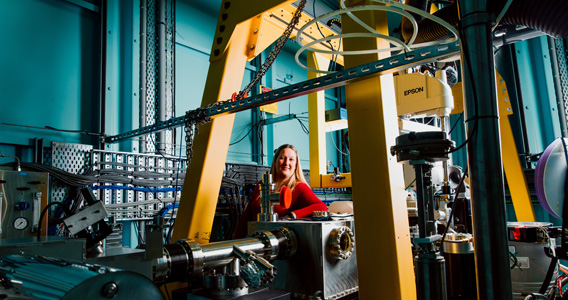 A nanoprobe beamline will provide a unique facility capable of spectroscopic and full-field imaging at sub-30 nm resolution. Operating in the range 2 – 22 keV the nanoprobe beamline will use an undulator source and a very long beamline, of order 100 m, to deliver the highest brightness x-rays possible to an experiment.
A nanoprobe beamline will provide a unique facility capable of spectroscopic and full-field imaging at sub-30 nm resolution. Operating in the range 2 – 22 keV the nanoprobe beamline will use an undulator source and a very long beamline, of order 100 m, to deliver the highest brightness x-rays possible to an experiment.
The nanoprobe beamline will be a complementary facility to the x-ray fluorescence microprobe, which is the most oversubscribed beamline at the Australian Synchrotron. The beamline will offer increased sensitivity for high resolution imaging as well as extended capability for full-field and phase imaging. With a cryogenic sample mount the system will also provide the ability to probe frozen hydrated biological samples, imaging and identifying cellular substructures that are critical components in biological machinery but are far smaller than current beam spots can resolve.
Techniques will include a suite of imaging and spectroscopic methods including:
- μ-XAS (x-ray absorption spectroscopy) and XAS imaging;
- XRF (x-ray fluorescence) imaging;
- Transmission and fluorescence mode tomography;
- STXM (scanning transmission x-ray microscopy);
- Phase contrast imaging; and
- CDI (coherent diffractive imaging).
The beamline will use advanced fluorescence and differential phase contrast detectors, as well as photon counting detectors to maximise sensitivity and readout speed. Zone-plate optics will be used to deliver 30 nm resolution across the energy range in direct nanoprobe mode, while CDI can be used to increase resolution – ideally below 10 nm. In both modes state of the art laser-based interferometry readout will be used to enhance positioning and position feedback capability. Accessing the K-edges of elements from phosphorus to silver, the beamline will suit applications in:
- Environmental sciences;
- Geology;
- Condensed matter physics;
- Nanotechnology;
- Chemistry; and
- Biological sciences.
In addition, the high coherence properties of the beamline will make it suitable for the development of new techniques in coherent x-ray science – an area that has been undergoing tremendous growth in recent years. It is also an area that is particularly well served by research groups based in Australia. Examples include the application of coherent diffractive imaging methods such as Fourier Transform Holography, CDI and x-ray photon correlation spectroscopy. Access to the current generation of photon-counting detectors will be facilitated by a sufficiently long hutch design.
The nanoprobe development invites consultation with the existing microspectroscopy and imaging communities so as to so as to ensure compatibility with and extension of present capabilities. This may involve development of existing beamlines, such as micro-tomographic capability for XFM. A governing criteria for the nanoprobe will be its compatibility with a range of different beamlines, in particular those forming the spectroscopy and imaging suite at the Australian Synchrotron, which will allow the investigation of samples at multiple length scales and/or using multiple techniques.
The baseline user community is expected to be drawn from groups currently using microprobe or other methods that require access to some or all of:
- high sensitivity;
- high resolution;
- full field imaging;
- 3D imaging;
- extended energy range;
- cryogenic sample mounting
![]() Download HCN Proposal (pdf, 967kb)
Download HCN Proposal (pdf, 967kb)
![]() Download HCN Detailed Report 2011-09 (pdf, 276kb)
Download HCN Detailed Report 2011-09 (pdf, 276kb)
The members of the HCN Beamline Scoping Group are: Hugh Harris (Adelaide), Chris Ryan (CSIRO), Brian Abbey (Melbourne), Leann Tilley (Melbourne), David Paterson (AS), and Martin de Jonge (AS).
Enquiries may be directed to: Hugh Harris
Position: ARC QEII Fellow and Senior Lecturer at the University of Adelaide
Phone: +61 (0)8 8303 5060
Fax: +61 (0)8 8303 4358
Email: hugh.harris@adelaide.edu.au
Further Information
- Contact Andrew Peele or Kia Wallwork at asdp@synchrotron.org.au.











